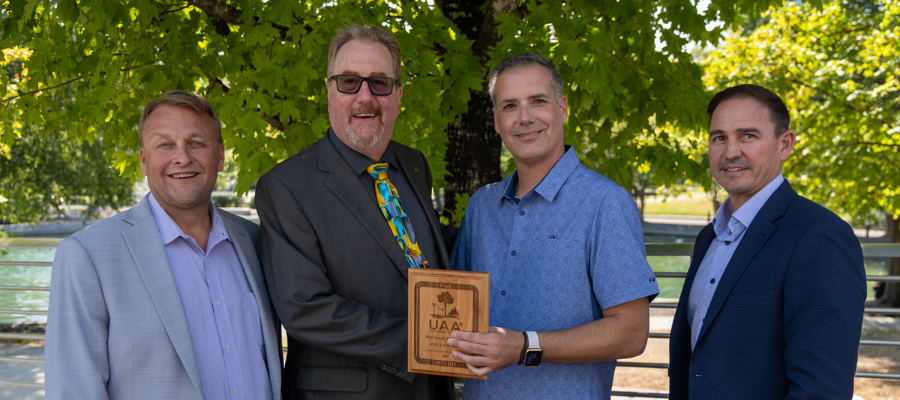By Bryan Durr, ACRT Pacific director of operations, and Kaylynn Ruf, ACRT Services director of human resources
An arborist should never trim a tree without a good reason and knowing how and when to prune is necessary — the same principle applies to recruiting.
Recruiting goes beyond filling empty positions. If companies recruit with a purpose, they can pinpoint whether they’re looking for premium talent to prepare for growth and identify future leaders, increase morale to improve engagement and create healthier workgroups, establish or further strengthen their competitive advantage as a value-add for clients — all while creating employee diversity to show evidence of a mature organization.
Premium talent. We like to use a football analogy of drafting a team. Better talent in organizations creates a healthy, competitive spirit. Once an organization’s needs are filled, sourcing and acquiring talent will breed healthy competitiveness and set your organization up for growth when the opportunity arises.
Increased morale. Maintaining staffing levels creates healthier workgroups, eliminates perceived time pressures, and as a result, reduces incident frequencies. It also establishes a more satisfying work-life balance and happier employees.
Competitive advantage. Our industry is in a state of resource shortages. Trumping the competition in hiring qualified resources offers a competitive advantage – and likely increased requests to fill vacancies or be selected as the preferred supplier when starting new projects.
Diversity. Diversity is a core value for many organizations, including ACRT Services and our family of companies. Hiring a diverse workforce demonstrates inclusion and a culture of acceptance. Professionals entering the workplace evaluate a company’s diversity as a point on their decision-making matrix.
An article published by Indeed shares, “When you hire the right candidate for a particular position, you avoid undergoing additional job searches for another professional. An employee who is a good fit for your company often continues to develop their skills and improve their performance within your organization once hired.”
When it comes to recruiting best practices, it’s important to remember these four points.
- Use a variety of sources, make contacts frequently and follow up, and use clear messaging.
- Reviewing and contacting applicants. Act fast – if you don’t contact your candidates quickly (via call, text, and email) chances are, they will have found another job.
- Consider using Behavioral Based Interviewing (BBI) by asking questions that prompt the candidate to give specific examples of their past behaviors – which leads to a better quality of hire and lower turnover.
- Internal team setup. The ideal way to structure a team to maximize quality hiring capacity is to dedicate one recruiter for every 25 requisites per business unit.
If your organization has a recruiting infrastructure in place, it’s possible to find success with little monetary investment. Remember to utilize your applicant pool from your tracking database – a recruiter or hiring manager can review prior applicants and reconnect. Reaching out to organization alumni is also a great opportunity. As many of us can attest, the grass isn’t always greener.
On the flip side, there are high-cost investments at recruiters’ disposal. By placing heavier investments in LinkedIn and Indeed, organizations have access to greater candidate networks.
If an organization decides to invest in its recruiting strategies, keep in mind that sourcing options may present a low return on investment (ROI). In our case, billboards, print/newspapers, mobile ads, and industry publication lists have proven to be routinely unsuccessful. Using industry publication lists to source candidates is taboo. We all swim in the same pond – don’t muddy the waters.
To evaluate an organization’s recruiting ROI, it’s important to look at the time it takes to fill each position, offer acceptance percentages, the top applicant and hiring sources, the cost per applicant, and the cost per hire.
The “5 Benefits of Hiring the Right Person” on LinkedIn shares, “Investing time in the search can save you money in the long run. Again, if your company is hurting, it’s difficult to be patient. However, slowing down and waiting for the right person means that you probably won’t have to go through the search again anytime soon. Sifting through applications and conducting interviews takes time and money. The more often you have to replace employees, the more money it costs.”
Indeed also suggests asking the following questions to evaluate the success of an organization’s recruitment process.
- How long did it take the new employee to effectively complete their tasks?
- Is the employee interacting well with their peers?
- How has the business grown since the employee became a member of the team?
- At what stage of the recruitment process did I realize the candidate was the right choice?
- What do I know now that I wish I’d known before I started searching for a new hire?
Recruitment and retention go hand-in-hand. High turnover in the first 90 days of employment is a sign of low candidate quality. As organizations invest in recruiting, this metric should decrease if recruiting is done successfully. Likewise, as organizations fill roles will quality hires, the number of open positions due to turnover will also decrease.
Investment in recruitment is a marathon, not a sprint. With improved recruitment and retention practices, organizations will see a long-term ROI, develop established business processes, and can deliver field training to their employees sooner.
With successful hiring will come increased retention and hiring quality candidates will contribute to lower turnover rates.




